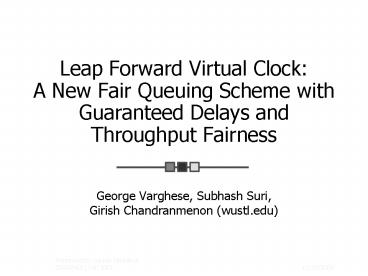Presented by Gaurav Navlakha - PowerPoint PPT Presentation
Title:
Presented by Gaurav Navlakha
Description:
A New Fair Queuing Scheme with Guaranteed Delays and ... when they are letting out an outburst of rage on being given the (despicable) bottle of milk? ... – PowerPoint PPT presentation
Number of Views:44
Avg rating:3.0/5.0
Title: Presented by Gaurav Navlakha
1
Leap Forward Virtual Clock A New Fair Queuing
Scheme with Guaranteed Delays and Throughput
Fairness
- George Varghese, Subhash Suri,
- Girish Chandranmenon (wustl.edu)
2
Leap Forward Virtual Clock
- Modifies Virtual Clock with Quarantine Leap
Forward Mechanisms - Achieves O(log(log N)) per packet processing cost
by Tag Coarsening (Van Emde Boas structure) - Ensures Throughput Fairness, Small Bounded Delay.
3
The Model
- Output Link S with bandwidth at least B bits per
second - Flow fi guaranteed a rate of ri bits/sec.
- S(ri) lt B
- pfk denotes kth packet in flow f
- lfk denotes size of pfk l(p)
- A(p) denotes the arrival time
- ts denotes the current server time
- tf denotes the service finish time for a packet
T(pjf)
4
Performance Parameters
- Computation
- Worst case computation time to dequeue a packet
in terms of the number of flows N. - Fairness F(t1, t2)
- maxf,g sentf (t1,t2)/rf - sentg(t1,t2)/rg ,
- where, max is over all backlogged flows
- Worst case Fairness (see paper)
- Delay Bounds (see paper)
5
Before LFVC
- FIFO most routers today implement it.
- Can lock out telnet type flows due to dominating
nature of large bandwidth applications such as
video conferencing - Round-robin
- poor worst case delay bounds waiting time is
dependent on the number of flows - WFQ (Tag Based on Deadlines)
- Provides Fair Throughput Sharing, Guaranteed
Delay Bounds, as well as Traffic Isolation - Only drawback Large Computational overhead of
O(N) per packet N is the number of flows
6
The Idea
- What to do with children when they are letting
out an outburst of rage on being given the
(despicable) bottle of milk? - Take them temporarily offline and try again when
theyre starved, and (thus) calm. - Do the same with packets that are arriving with a
vengeance! - The flow in need of some discipline is the one
that has recently received more than its
allocated share of bandwidth, since its flow tag
might violate the Throughput condition. (Such
flows are called oversubscribed) - Schedule them later when their deadline is
approaching near.
7
The Algorithm
- Two queues per output link, H (high priority) and
L (low priority). - Packets in oversubscribed flows are put in L
(Quarantined!). - Packets in the remaining well-behaved flows are
put in H. - The packet with lowest tag in H is scheduled for
service. (Service order is therefore, not
necessarily in ascending order of tags, as L may
have tags lower than H). - Finally the packets in L are restored to H before
their deadlines can be violated. - It is possible that H becomes empty whilst
doing so. In this case, increment the Virtual
Clock (Leap Forward!) till at least one Flow in L
becomes eligible for transfer to H.
8
Delay Throughput Conditions
- T(pjf) maxtfprev, ts ljf/rf
- tf
- T(pjf) , if flow f is active
- maxtfprev, ts , otherwise
- Delay Condition
- lf (f?F) rf(t-tf) (f?F) lt (t-ts) B
- Throughput Condition
- tf lt ts k.?f (k is independent of N)
9
Transfer conditions (H??L)
- Safe condition to keep in L (Delay deadline is
not violated) - (tf ts) gt ?f
- (tf ts) gt ?f t (more precise)
- (t L/B the maximum sized packet amongst all
flows) - Safe condition to keep in H (Throughput condition
is not violated) - tf lt ts ?f (fixing k1)
- tf lt ts ?f t (raised in order to match the
improved Delay condition above) - (Theres a pleasing symmetry in above 2
conditions) - Organize L as a priority queue with key (tf - ?f)
instead of tf (as in H). This helps make 2 tasks
extremely efficient - Decide the time to set during Leap Forward
- Pick packets to transfer from L to H
10
Rounded Tags
- Round up Tag values to whole multiples of ?
- Causes minor increase in the delay and throughput
bounds, but substantially reduces computational
overhead needed for sorting tags. - New conditions for transfer between H and L have
a factor of ? added on the RHS.
11
Contributions
- Two non-trivial modifications to the classical
Virtual Clock algorithm - Provides throughput fairness even in a worst-case
sense, without compromising delay bounds - Simple algorithm to implement at routers
- Quarantine structure L can be replaced by delay
regulator to provide jitter guarantees - Adds approximate tags - it could throw fairness
and delay bounds, to the wind. Proving that it
doesnt, is non-trivial. - Eventual goal of the work is to allow Gigabit
routers to deploy powerful schedulers without
compromising the need for fast forwarding
performance































